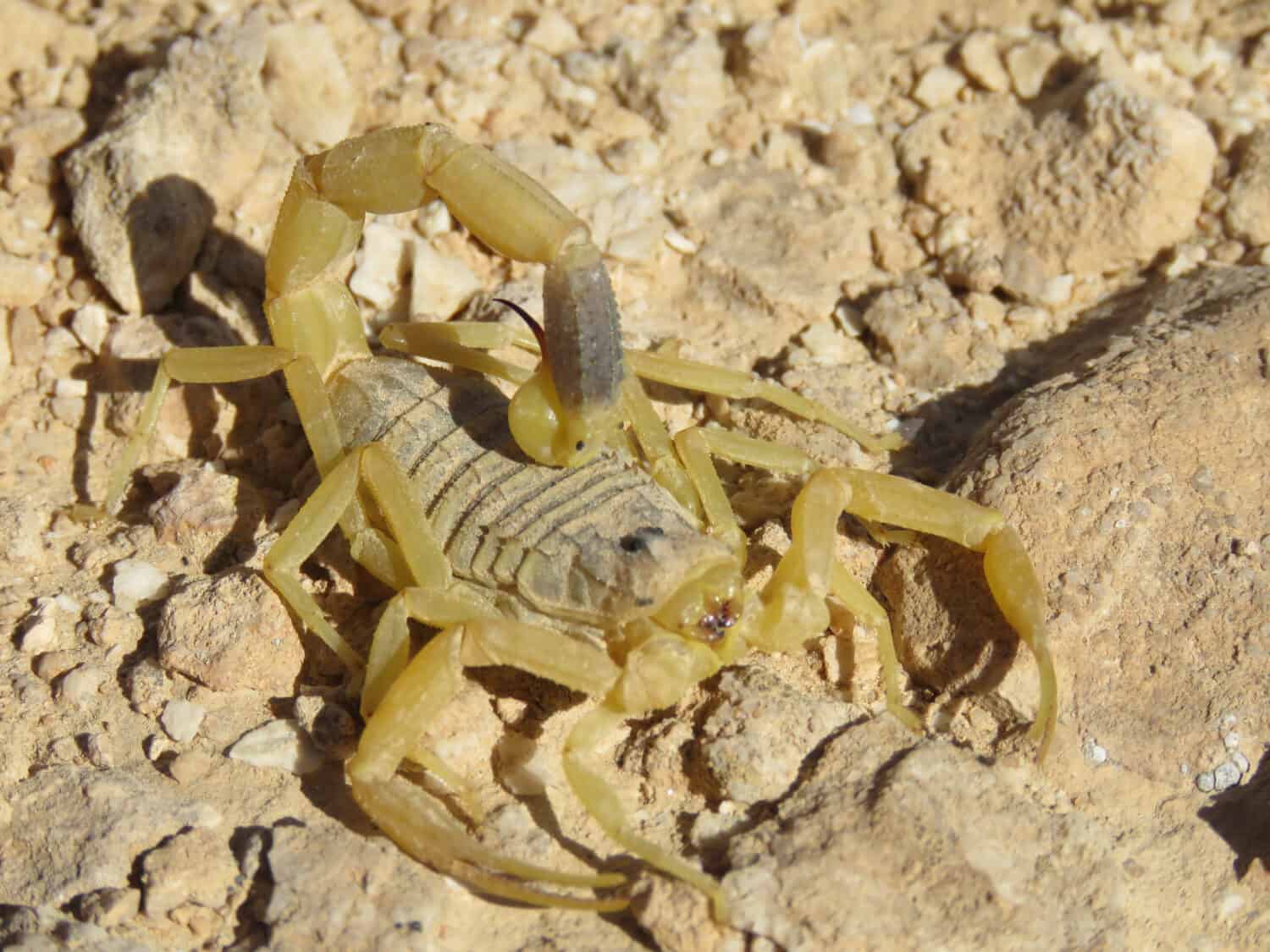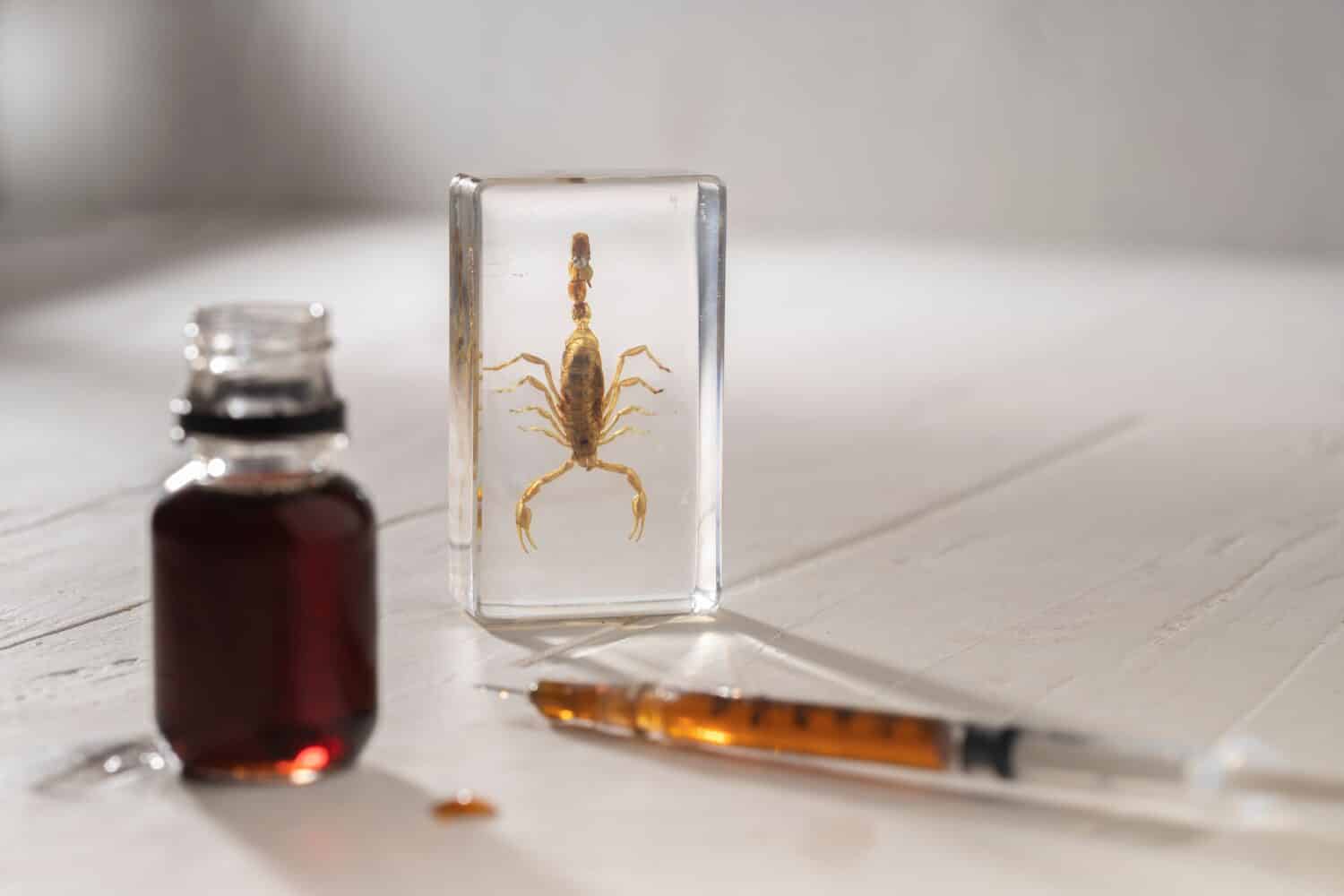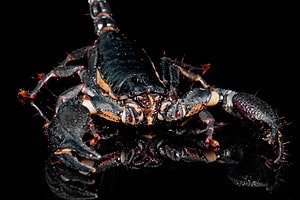Scorpion venom is the most expensive liquid in the world! Although scorpions deliver painful stings, their valuable venom has many uses in the medical field. Discover how venom is extracted and used for medical purposes and why a gallon of one scorpion’s venom is being sold for $39 million!
The Most Dangerous Scorpion — Deathstalker Scorpions
You can probably guess from its name that the deathstalker scorpion (Leiurus quinquestriatus) is the most dangerous of its species. The animal’s scientific name roughly translates to “five-striped smooth-tail,” which gives you an idea of the creature’s appearance.
Deathstalker scorpions are typically pale yellow in color with horizontal stripes down their back. They have flat bodies which allow them to hide in small cracks and are actually smaller in size and more agile than the average scorpion.
What the deathstalker lacks in size, it makes up for in powerful venom. These creatures move quickly across the desert floor, grabbing prey such as crickets and taking it down with a venomous sting.

Deathstalker scorpions are pale yellow in color.
©Bens_Hikes/Shutterstock.com
Deathstalker scorpions live in Northeastern Africa and the Middle East. They are sometimes called the Palestine yellow scorpion, Omdurman scorpion, and Naqab desert scorpion. Though the deathstalker can be dangerous, its venom is becoming extremely valuable in the medical field.
Medical and Scientific Uses
Venom from deathstalker scorpions contains a powerful mixture of neurotoxins. While a sting from this creature won’t usually kill a healthy adult, it could prove fatal for young children, the elderly, or those who have an anaphylactic allergic reaction. Being stung by a deathstalker scorpion is a medical emergency regardless of age.
This brings us to the first medical use for deathstalker scorpion venom — the creation of antivenom. An Arizona State University biologist explains the effects of deathstalker scorpion venom.
The protein chlorotoxin is present in the venom. When a human gets stung, the chlorotoxins block channels on the surface of our cells. Once the channels are blocked, our muscles can’t relax. The venom causes reactions such as extreme pain, headache, drowsiness, and swelling.
Antivenom works by making it impossible for chlorotoxins to continue blocking channels. Antivenom can’t reverse the damage the venom has already done. However, it does prevent further damage. Eventually, our bodies repair the rest of the ill effects.
Identifying Brain Cancer Cells with Deathstalker Venom
You’ve probably heard of the use of antivenom before, but deathstalker scorpions have made an even more fascinating contribution to the medical field in the form of cancer research. In patients with brain cancer, gliomas make up the most lethal malignant tumors.
Gliomas infiltrate the brain and invade healthy brain tissue. Treatment involves surgery to remove the tumor if it is accessible, followed by chemotherapy. Yet even after all this, the patient’s five-year survival rate is at best 3%, according to a paper from MDPI.
Gliomas are especially challenging to deal with due to their resistance to radiation and chemotherapy. When removing gliomas, surgeons find it difficult to accurately localize them within the tissue. In fact, the cells in a glioma look similar to healthy brain cells.

Deathstalker scorpion venom is being used in the medical field.
©Slashio photography/Shutterstock.com
Current imaging techniques make it possible to roughly visualize the tumor, but determining the exact boundaries of the tumor invasion is tedious and difficult. This is where deathstalker scorpion venom comes in.
A paper from the American Association for Cancer Research explains that “glioma cells have recently been shown to express a glioma-specific chloride ion channel (GCC)” that is sensitive to the chlorotoxins from deathstalker scorpion venom.
In clinical trials, chlorotoxins from the venom are combined with a fluorescent molecule to create a kind of “paint.” The paint binds to the glioma, highlighting the cancerous cells and helping surgeons remove as many cancerous cells as possible while keeping healthy cells intact.
Rarity and Value
Scorpion venom is one of the most expensive liquids in the world, and deathstalker venom is the most valuable of all. One gallon of venom from the deathstalker scorpion costs $39 million! There are many reasons for the high price of deathstalker venom.
First, scorpion venom is expensive in general because it’s not easy to get. People commonly extract venom by hand and scorpions can only produce two milligrams of venom at a time.
Deathstalker scorpions aren’t particularly rare. The value of their venom goes up thanks to the added danger of handling the deadliest scorpion in the world. The many medical uses of deathstalker venom also increase its worth.
Ethical and Sustainability Considerations
In the past, accessing scorpion venom often involved killing the creature. Today, there are methods to extract venom without causing harm. One of the most common involves using a pair of tweezers and tongs and an electro-stimulator that delivers a low voltage, causing the scorpion to release venom.
Evolutionary biologist Dr. Arie van der Meijden of the CIBIO-InBIO Institute in Portugal explained the benefits of this method to IFLScience. He stated that the extraction does not harm the animal at all and in fact, the scorpion will resume normal activities like eating immediately after.
However, there are also those who do cause harm to the animal. “I have seen people extracting scorpion venom using really high voltages… and you see the smoke coming out of the scorpion,” der Meijden continued. “Obviously, that poor thing is very badly harmed.”
The photo featured at the top of this post is © Protasov AN/Shutterstock.com
Thank you for reading! Have some feedback for us? Contact the AZ Animals editorial team.







